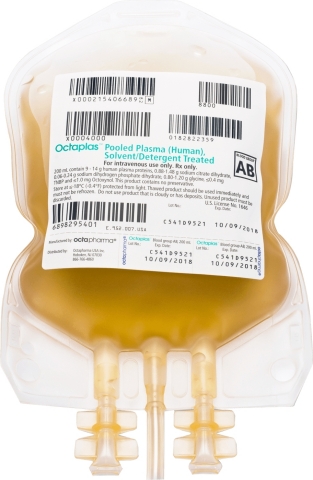HOBOKEN, N.J.--(BUSINESS WIRE)--The U.S. Food and Drug Administration (FDA) has approved a revised product label for Octapharma USA’s Octaplas™, Pooled Plasma (Human), Solvent/Detergent Treated Solution for Intravenous Infusion. The new labeling provides the results of a post-marketing study on Octaplas™ that demonstrates the product’s safety, efficacy and tolerability in treating critically ill pediatric patients who require replacement of multiple coagulation factors.
“The results of this study provide clinical evidence supporting the use of Octaplas™ in critically ill pediatric patients with acquired deficiencies who require replacement of multiple coagulation factors due to liver disease or who are undergoing cardiac or liver transplant surgery,” said Octapharma USA President Flemming Nielsen. “The results of the present study and those of previous studies comparing Octaplas™ with fresh frozen plasma support its use in this patient population.”1
Study Details
The prospective, open-label, multicenter, single arm, post-marketing study assessed 50 pediatric patients age 16 years and under (37 neonates/infants, less than age 2; and 13 children/adolescents, age 2 to 16). Study participants included 40 cardiac surgery patients, 5 liver transplant/dysfunction patients, 4 sepsis-related coagulopathy patients and 1 patient with hypoxic encephalopathy. For complete trial details, please visit ClinicalTrials.gov; clinical trial identifier: NCT02050841.
Patients were dosed based on body weight and doses were adjusted as needed. There were no hyperfibrinolytic or treatment-related thromboembolic events reported by investigators. Overall safety was assessed by investigators as “excellent” for all 50 patients. Hemostatic parameters as measured by international normalized ratio (INR), prothrombin time (PT), activated partial thromboplastin time (aPTT), and thromboelastography (TEG) were within expected ranges following use of Octaplas™.1
The study results demonstrating the safety of Octaplas™ in the management of critically ill pediatric patients were presented at the Society of Cardiovascular Anesthesiologists Annual Meeting.
Background
Correction of an abnormal coagulation profile is the most common indication for plasma transfusions.2 Clinical practice guidelines recommend plasma transfusion in children and neonates with an abnormal coagulation profile and clinically significant bleeding or prior to invasive procedures with a high bleeding risk.3
Several types of plasma products are available for transfusion, including fresh frozen plasma (FFP) or solvent/detergent (S/D)-treated, pooled plasma.4 Octaplas™ is a S/D treated, virus inactivated, blood group-specific human plasma prepared from pooling multiple single donor FFP units resulting in a standardized composition with significantly lower variability in coagulation factor content compared to standard FFP.5 In comparison to FFP, Octaplas™ is practically cell free, and contains significantly lower residual platelet concentrations and negligible amounts of microparticles due to its manufacturing process.6 Octaplas™ offers a safety benefit as a result of the pathogen inactivation and removal of cells or cell fragments during the manufacturing process.
About Octaplas™
Octaplas™ is a solvent/detergent (S/D) treated, pooled human plasma indicated for replacement of multiple coagulation factors in patients with acquired deficiencies due to liver disease or who are undergoing cardiac surgery or liver transplantation; and plasma exchange in patients with thrombotic thrombocytopenic purpura (TTP).
WARNINGS AND PRECAUTIONS
Transfusion reactions can occur with ABO blood group mismatches; high infusion rates can induce hypervolemia with consequent pulmonary edema or heart failure; excessive bleeding due to hyperfibrinolysis can occur due to low levels of alpha 2-antiplasmin; thrombosis can occur due to low levels of Protein S; citrate toxicity can occur with volumes exceeding one milliliter of Octaplas™ per kg per minute; Octaplas™ is made from human blood and may carry the risk of transmitting infectious agents, e.g., viruses and theoretically, the variant Creutzfeldt-Jakob disease and Creutzfeldt-Jakob disease agent.
Please see full prescribing information at www.octaplasus.com.
About the Octapharma Group
Headquartered in Lachen, Switzerland, Octapharma is one of the largest human protein products manufacturers in the world and has been committed to patient care and medical innovation since 1983. Its core business is the development and production of human proteins from human plasma and human cell lines. Octapharma employs approximately 8,314 people worldwide to support the treatment of patients in over 115 countries with products across the following therapeutic areas: Hematology (coagulation disorders), Immunotherapy (immune disorders) and Critical Care. The company’s American subsidiary, Octapharma USA, is located in Hoboken, N.J. Octapharma operates three state-of-the-art production sites licensed by the U.S. Food and Drug Administration (FDA), providing a high level of production flexibility. For more information, please visit www.octapharmausa.com.
REFERENCES
1. Data on file, Octapharma USA, 2019.
2. Labarinas, S., Arni, D.,
Karam, O.: Plasma in the PICU. Annals of Intensive Care. 3, 16 (2013).
3.
New, H. V., Berryman, J., Bolton-Maggs, et al.: Guidelines on
transfusion for fetuses, neonates and older children. Br. J. Haematol.
175, 784–828 (2016).
4. Camazine, M. N., Karam, O., Colvin, R., et
al.: Outcomes Related to the Use of Frozen Plasma or Pooled
Solvent/Detergent-Treated Plasma in Critically Ill Children. Pediatric
critical care medicine a journal of the Society of Critical Care
Medicine and the World Federation of Pediatric Intensive and Critical
Care Societies. 18, e215-e223 (2017).
5. Heger, A., Romisch, J.,
Svae, T.-E.: A biochemical comparison of a pharmaceutically licensed
coagulation active plasma (Octaplas) with a universally applicable
development product (Uniplas) and single-donor FFPs subjected to
methylene-blue dye and white-light treatment. Transfus. Apher. Sci. 35,
223–233 (2006).
6. Spinella, P. C., Frazier, E., Pidcoke, et al.:
All plasma products are not created equal. J. Trauma Acute Care Surg.
78, S18-25 (2015).
OPLAS-0124




